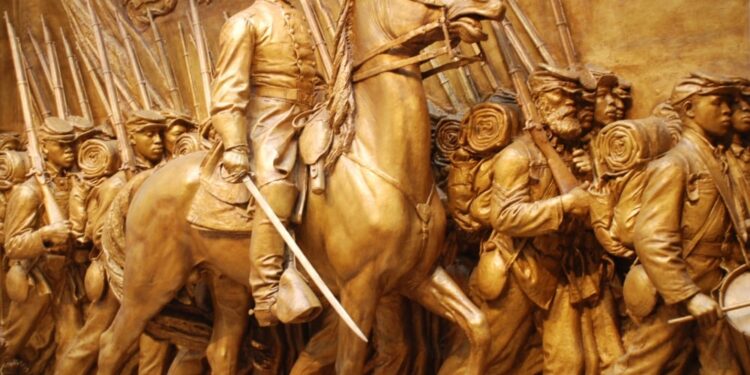Critically appreciate Robert Lowell’s poem For the Union Dead
Critically appreciate Robert Lowell’s poem For the Union Dead-For the Union Dead by Robert Lowell is a deeply impactful poem that not only serves as a meditation on history, memory, and societal change but also reflects Lowell’s personal and cultural perspectives. Written during a time of social upheaval in the 1960s, the poem engages with the evolving landscape of Boston, connecting it to broader themes of war, loss, and the shifting nature of American identity.
Thematic Exploration:
1. War and Its Aftermath:
- The opening line of the poem presents a striking depiction of a war memorial, with special attention paid to Colonel Shaw and the 54th Massachusetts Regiment. The imagery from the Civil War contrasted with modern settings emphasizes the lasting effects of war on the American psyche. Lowell challenges readers to think about the price of war and the nuanced legacy it leaves in its wake.
2. Decay and Change:
- The poet deftly uses the Boston Aquarium’s deterioration as a metaphor for the loss of cultural legacy and society’s decline. The dilapidated aquarium turns into a neglect symbol, expressing the poet’s worries about the declining morals and historical awareness in modern-day America.
3. Historical Continuity:
- Lowell weaves a thread of historical continuity throughout the poem, connecting the past with the present. The references to Colonel Shaw, the 54th Massachusetts Regiment, and the Boston Aquarium create a narrative that transcends time. This approach underscores the importance of understanding history as a living force that shapes the present.
4. Social Critique:
- With regard to consumerism, commercialization, and the loss of cultural and historical awareness, Lowell presents a powerful social critique. The stark, commercialized present contrasted with the colorful, alive world of the past offers a commentary on the values of modern society.
5. Alienation and Isolation:
- The poem explores the theme of alienation, both individual and societal. The speaker’s sense of isolation is palpable, reflecting a broader societal detachment from history and a disconnection from the sacrifices of the past. This theme resonates with the larger cultural shifts occurring during the 1960s.
Also Read-
- How does the choice of words in the poem I Taste a Liquor Never Brewed help to illustrate the idea of drunkenness
- Enumerate on the Revolutionary War and Treaty of Paris and their impact on American poetry
- Discuss the symbols in the story The Empty Chest
Stylistic Elements:
1. Imagery:
- The poem’s emotional resonance is enhanced by Lowell’s use of rich and emotional imagery. The deteriorating aquarium, the bustling cityscape, and the war memorial are all rendered in remarkable detail. Because of Lowell’s vivid imagery, readers are able to picture and relate to the scenes he depicts on an emotional level.
2. Symbolism:
- The poem heavily relies on symbolism. For instance, the aquarium is a complex symbol that denotes the deterioration of historical and cultural values in addition to the physical deterioration of structures. The 54th Massachusetts Regiment and Colonel Shaw serve as symbols of the ongoing fight for civil rights and sacrifice.
3. Allusions and Intertextuality:
- Lowell’s poem is densely layered with literary and historical allusions. References to figures like Hawthorne and Melville, along with historical events, add depth and complexity to the poem. This intertextuality invites readers to engage with a broader cultural and intellectual context, enriching their understanding of the work.
4. Shifts in Tone:
- The poem skillfully navigates shifts in tone, moving from reflective and contemplative moments to more urgent and critical passages. These tonal shifts contribute to the dynamic nature of the poem, keeping the reader engaged and emphasizing the emotional intensity of the speaker’s observations.
Historical Context:
1. Civil Rights Movement:
- “For the Union Dead” was written at the height of the Civil Rights Movement and captures the social unrest and political unrest of the 1960s. The poem is in line with the current fight for racial equality because of its reference to the 54th Massachusetts Regiment, an African American unit that fought for the Union during the Civil War.
2. Urban Renewal and Modernization:
- The poem depicts how historical landmarks are impacted by urban renewal and modernization. Boston, located in Lowell, is a city that is rapidly changing, with new commercial buildings taking the place of older ones. This is consistent with the larger national trend of inner-city neighborhood decline and suburbanization.
3. Cultural Anxiety:
- The poem encapsulates a cultural anxiety prevalent in the 1960s—a sense of loss and disorientation amid rapid social change. Lowell’s exploration of the past as both a source of inspiration and a burden reflects the broader societal questioning of values and identity during this tumultuous era.















